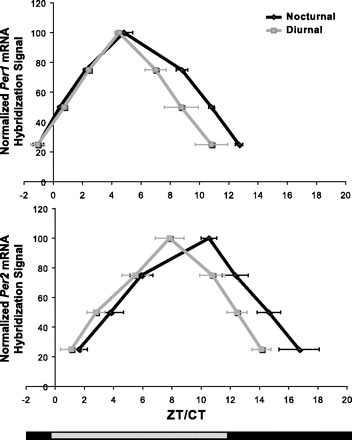Fig. 7.

Comparative analysis of published Per1 and Per2 rhythms in the SCN of diurnal and nocturnal species. The timing and shape of Per1 and Per2 mRNA rhythms were compared from published studies of adult animals with clearly defined chronotypes (7, 9, 10, 20, 27, 31, 34–35, 37–38, 43, 59, 62, 64–65). Papers that were excluded from the analysis included studies of Period gene expression in the sheep (28) because of unusual photoperiod, the blind mole rat (44) because of ambiguous chronotype (48), and studies of the juvenile rat and rabbit (11, 56) because of possible developmental confounds. To compare Period gene expression patterns, the published rhythms were normalized as previously described. Based on this normalization, mRNA hybridization levels of 25, 50, and 75% of peak expression were estimated and averaged to create a “typical” Per1 and Per2 waveform for each species. To compare the two chronotypes, the species’ means were averaged to produce typical diurnal and nocturnal Per1 and Per2 waveforms. This method prevented well-studied species from being overrepresented.
